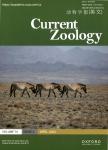Color and behavior differently predict competitive outcomes for divergent stickleback color morphs
Color and behavior differently predict competitive outcomes for divergent stickleback color morphs作者机构:Department of Biological Sciences University of Denver 2199 S. University Blvd Denver CO 80208 USA
出 版 物:《Current Zoology》 (动物学报(英文版))
年 卷 期:2018年第64卷第1期
页 面:115-123页
核心收录:
学科分类:0710[理学-生物学] 1305[艺术学-设计学(可授艺术学、工学学位)] 1304[艺术学-美术学] 13[艺术学] 0905[农学-畜牧学] 0906[农学-兽医学] 09[农学]
基 金:supported by the University of Denver, including through Partners in Scholarship Summer Research grants to Jolysa Gallegos, Brian Ketterman Kyle Robrock. Three anonymous reviewers and Maria Servedio provided feedback that greatly improved the article
主 题:竞争能力 颜色 行为 分叉 预言 繁殖季节 鱼 不对称现象
摘 要:Our knowledge of how male competition contributes to speciation is dominated by investigations of competition between within-species morphs or closely related species that differ in conspicuous traits expressed during the breeding season (e.g. color, song). In such studies, it is important to consider the manner in which putatively sexually selected traits influence the outcome of competitive interactions within and between types because these traits can communicate information about competitor quality and may not be utilized by homotypic and heterotypic receivers in the same way. We studied the roles of breeding color and aggressive behaviors in competition within and between two divergent threespine stickleback color types. Our previous work in this system showed that the switch from red to black breeding coloration is associated with changes in male competition biases. Here, we find that red and black males also use different currencies in competition. Winners of both color types performed more aggressive behaviors than losers, regardless of whether the competitor was of the same or opposite color type. But breeding color differently predicted competitive outcomes for red and black males. Males who were redder at the start of competition were more likely to win when paired with homotypic competitors and less likely to win when paired with heterotypic competitors. In contrast, black color, though expressed in the breeding season and condition dependent, was unrelated to competitive outcomes. Placing questions about the role of male competition in speciation in a sexual signal evolution framework may provide insight into the why and how of aggression biases and asymmetries in competitive ability between closely related morphs and species.



